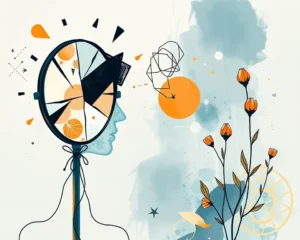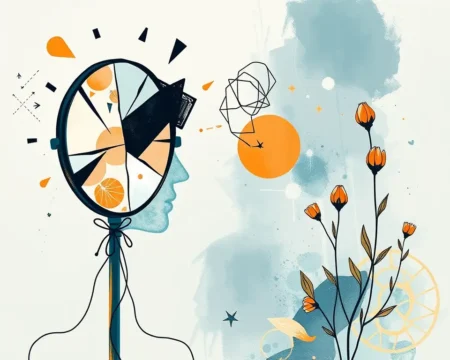Introspection, the act of looking inward to examine one’s own thoughts, feelings, and motivations, has played a significant role in the history and development of psychology. While its prominence as a primary research method has waned, introspection remains a valuable tool for self-discovery, personal growth, and therapeutic interventions. This article delves into the intricacies of introspection, exploring its history, applications, benefits, and limitations within the field of psychology.
What is Introspection?
Introspection is a psychological process that involves examining one’s own conscious thoughts and feelings. It’s a deliberate and conscious effort to understand the inner workings of our minds. Introspection is closely related to self-reflection and self-discovery, and it stands in contrast to external observation. It provides privileged access to one’s own mental states, an access that is unique and unmediated by other sources of knowledge.
In simpler terms, introspection is like taking a mental step back to observe your own thoughts and emotions as they arise. It’s about paying attention to your internal experiences without judgment, allowing you to gain insights into your motivations, beliefs, and values.
Key Features of Introspection
To better understand what constitutes introspection, it’s helpful to consider its defining features:
- First-person perspective: Introspection involves examining one’s own mind, not someone else’s.
- Mental states: It focuses on mental events, states, or processes, such as thoughts, emotions, sensations, and perceptions.
- Awareness: It requires a level of awareness of one’s own mental activity.
- Reflection: It involves consciously examining and analyzing one’s internal psychological processes.
A Brief History of Introspection in Psychology
Introspection has a long and fascinating history in psychology, dating back to the discipline’s early days as a scientific endeavor.
Wilhelm Wundt and the Birth of Experimental Psychology
Wilhelm Wundt, often regarded as the father of experimental psychology, played a pivotal role in introducing introspection as a research technique. In 1879, Wundt established the first psychology laboratory in Leipzig, Germany, where he and his colleagues conducted experiments to study the structure of consciousness.
Wundt believed that the human mind was composed of basic elements: sensations and feelings. His method, known as experimental self-observation, involved training individuals to carefully and objectively analyze the content of their own thoughts in response to controlled sensory stimuli. Participants would be presented with a stimulus, such as a light or sound, and then asked to describe their immediate sensations and feelings.
Wundt emphasized rigorous control and precision in the introspective process. Observers were highly trained to minimize subjective interpretation and to provide simple, quantifiable responses, such as “yes” or “no.” The goal was to break down conscious experience into its fundamental components and to identify the laws governing their combination.
Edward Titchener and Structuralism
Edward Titchener, a student of Wundt, further developed and popularized introspection in America. Titchener established a psychology laboratory at Cornell University and became a leading proponent of structuralism, a school of thought that sought to identify the basic elements of consciousness and how they combine to form complex mental experiences.
Titchener’s approach to introspection was more elaborate than Wundt’s. He encouraged his students to undergo extensive training in introspection, learning to describe their feelings and sensations in great detail when presented with a stimulus. Titchener expanded introspection to include memory, thought, and feeling, as well as sensation and perception.
The Decline of Introspection as a Research Method
Despite its early promise, introspection as a primary research method eventually fell out of favor in psychology. Several factors contributed to its decline:
- Subjectivity: Introspection relies on personal experience, making it difficult to verify and replicate findings. Different individuals often provide varying introspective reports about the same stimulus, raising concerns about reliability.
- Lack of access to unconscious processes: Introspection is limited to conscious awareness and cannot provide insights into unconscious mental processes, which many psychologists believe play a significant role in behavior.
- The rise of behaviorism: Behaviorism, a school of thought that emphasized the study of observable behavior, emerged as a dominant force in psychology in the early 20th century. Behaviorists rejected introspection as unscientific and focused on objective methods of investigation, such as experiments and observations.
- The introspection illusion: People may give confident descriptions of their mental processes, being “unaware of their unawareness”.
Introspection’s Enduring Legacy
While introspection is no longer a central research method in psychology, it has left an enduring legacy. It helped lay the groundwork for modern experimental approaches to understanding the human mind. It contributed to the development of self-report techniques, such as questionnaires and interviews, which are widely used in psychological research today.
How Introspection Is Used Today
Although formal introspection is rarely used as a research tool, the practice of looking inward remains relevant in several areas of psychology and everyday life:
Self-Awareness and Personal Growth
Introspection is a valuable tool for increasing self-awareness and promoting personal growth. By reflecting on our thoughts, feelings, and behaviors, we can gain a deeper understanding of our values, motivations, and patterns of behavior. This self-knowledge can help us make more informed decisions, improve our relationships, and lead more fulfilling lives.
Psychotherapy
Introspection plays a key role in many forms of psychotherapy. Therapists often encourage clients to explore their thoughts and feelings to gain insight into their psychological issues. Through introspection, clients can identify the underlying causes of their problems, develop coping strategies, and work towards personal growth and healing.
Mindfulness and Meditation
Mindfulness and meditation practices often involve introspection. By paying attention to our thoughts and feelings without judgment, we can cultivate a greater sense of self-awareness and inner peace. Introspection can help us to become more present in the moment and to develop a more compassionate relationship with ourselves.
Cognitive Psychology
Although modern cognitive psychology relies more on objective measures, introspection still plays a role in some areas, particularly in understanding subjective experiences and cognitive processes. For example, “think aloud protocols” involve participants verbalizing their thoughts while performing a task, providing insights into their cognitive strategies.
Improved Problem-Solving and Creativity
Introspection fuels creativity by allowing people to process experiences and learn from them. Self-reflection questions, followed by writing about experiences, can generate new perspectives and solutions, especially when used as support for psychotherapy
Types of Introspection
While the core principle of introspection remains the same – examining one’s own thoughts and feelings – different approaches emphasize various aspects of the process. Here are some notable types of introspection:
- Descriptive Introspection: Focuses on providing a detailed account of internal experiences at a specific moment, including thoughts, emotions, physical sensations, and sensory perceptions.
- Phenomenological Introspection: Explores conscious experiences as they are directly experienced, without any preconceived notions or external interpretations. Aims to understand the structure and meaning of experiences as they present themselves in consciousness.
- Reflective Introspection: Emphasizes self-reflection and systematic self-observation of one’s thoughts, feelings, and behaviors. Helps individuals identify thought patterns, understand underlying beliefs, and gain insights into motivations and emotions.
Benefits of Introspection
Engaging in introspection offers numerous potential benefits for individuals:
- Increased self-awareness: Introspection helps us to become more aware of our thoughts, feelings, and behaviors, allowing us to understand ourselves better.
- Improved emotional regulation: Reflecting on our emotions and recognizing triggers and glimmers can help us manage our responses to stressors and challenging situations.
- Better decision-making: Introspection can help us to clarify our values and goals, enabling us to make more informed and aligned decisions.
- Stronger relationships: Understanding ourselves better can lead to improved empathy and communication skills, strengthening our relationships with others.
- Enhanced problem-solving and creativity: Introspection allows us to process experiences and learn from them, generating new perspectives and solutions.
- Increased resilience: By developing a deeper understanding of ourselves, we can build resilience and cope with life’s challenges more effectively.
- Improved Mental Health: Therapists use introspection to help clients explore their own inner experiences, assess their emotional state, and gain insight into their behavior.
Potential Pitfalls and Limitations of Introspection
Despite its potential benefits, introspection also has limitations and potential pitfalls:
- Subjectivity and bias: Introspection is based on subjective experience, which can lead to biased and partial interpretations of reality.
- Limited access to unconscious processes: Introspection is limited to conscious awareness and cannot provide insights into unconscious mental processes.
- Inaccuracy: Studies have shown that people are often unaware of the factors that influence their thoughts and behaviors, leading to inaccurate introspective reports.
- Rumination: Introspection can sometimes lead to rumination, a negative and repetitive thought pattern that can worsen mental health problems.
- Introspection Illusion: Even when introspections are uninformative, people still give confident descriptions of their mental processes, being “unaware of their unawareness”.
Introspection vs. Rumination
It’s important to distinguish between introspection and rumination. While both involve thinking about one’s thoughts and feelings, they differ significantly in their focus and outcomes. Introspection is about growth, we look inward in order to learn, and is a process of healthy self-reflection, examination, and exploration, which is good for your well-being and your brain. Rumination, however, is about getting stuck, and feels like not just going in circles, but also digging yourself further into your distressed feelings.
How to Practice Productive Introspection
To maximize the benefits of introspection and minimize its potential pitfalls, it’s essential to practice it in a productive and balanced way:
- Set aside dedicated time: Find a quiet and comfortable space where you can reflect without distractions.
- Be mindful: Pay attention to your thoughts and feelings without judgment.
- Ask yourself questions: Explore your motivations, values, and patterns of behavior.
- Be honest with yourself: Acknowledge your strengths and weaknesses without self-criticism.
- Focus on solutions: Use introspection to identify problems and develop strategies for change.
- Practice self-compassion: Treat yourself with kindness and understanding.
- Consider different perspectives: With introspection, there is a sense that you are exploring something, considering new perspectives, and are more aware of feelings.
- Ask “what” questions: Ask “what” questions, such as “what is in my control?”, rather than “why” questions including “why do I feel so stressed?”.
Conclusion
Introspection, the practice of looking inward to examine one’s own thoughts and feelings, has played a multifaceted role in psychology. While it has limitations, introspection remains a valuable tool for self-discovery, personal growth, and therapeutic interventions. By practicing introspection in a mindful and balanced way, we can unlock its potential to enhance our self-awareness, improve our relationships, and lead more fulfilling lives.










